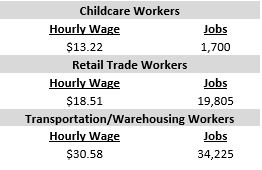The cost of childcare poses families with a difficult decision that can have an impact on the regional labor force. While some jobs provide flexible hours and make exceptions for childcare needs, many families still must decide if a parent should work and pay for childcare or stay home with the children. Public policy around childcare can impact the regional labor force but the current childcare market makes it difficult for policy changes alone to grow childcare to meet demand. Childcare shortages can be damaging to the growth of a local economy, and the availability of childcare is a major factor in talent attraction.
More people in the workforce stimulates local economies, generating higher local tax earnings through payroll taxes. Current estimates show that a 10% increase in childcare availability would lead to a 1% increase in labor force participation for female workers aged 35-44. In the State of Kentucky, childcare subsidies stop for families who have a household income over $53,000 a year which is 80% of the state median household income. In states like New Mexico, childcare is covered for all families who make less than 200% of the state median household income. This means for a Kentucky family where one partner earns at least $53,000, childcare costs become an economic decision to determine if the other partner should work.
The scenario shown includes childcare and tax costs for a family of four living in Northern Kentucky with one partner earning $53,000 a year and the second partner deciding to work or stay home. Net take-home pay is the pay after taxes and childcare costs. For the second partner to break even from their job after childcare and tax costs, they would need to earn more than $16 an hour or $33,280 a year. When considering extra costs for childcare and a full-time job, such as car payments, insurance, general travel expenses and opportunity costs of having to work, a parent should ideally be taking home $400 a week, which would equate to earning more than $29 per hour or more than $60,000 per year.
Keeping childcare workers in the industry and expanding and adding more locations/workers is proving to be very difficult. Retail and Transportation/Warehousing positions can offer much more competitive wages than a job in childcare, and with a shortage of human labor in those industries, childcare expansion seems impossible. For example, the table below details the jobs and wages of workers in the childcare, retail, and transportation/warehousing industries.

NKY Works, an impact initiative under the Northern Kentucky Area Development District, has prioritized improving the childcare landscape within the region. Its childcare initiative has three focus areas: employer incentives, childcare industry talent attraction and retention and workforce talent attraction and retention. The early childhood education team is led by Sandra Woodall, executive director and CEO of EC Learn, and Kate Dean, regional childcare administrator. To continue improving the childcare system, the region needs quality, affordable, and reliable childcare; investments in the early childhood career talent pipeline; and financial incentives for those pursuing advanced certifications.
Ashby Drummond is Research Analyst for BE NKY Growth Partnership.









